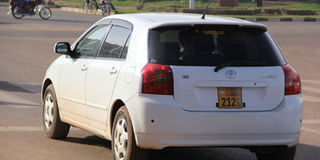Which of these Toyota cars - Allex, RunX and Ist - is the best

The Toyota RunX is a Sprinter which makes it a good option. It offers you a better balance between engine power and fuel economy. FILE PHOTO
Hi, I am planning to buy a fuel-efficient car. Having owned a Progress and a Mark II, I finally decided it’s time to drive something that is good and fuel-efficient. Could you kindly advise me between the Toyota IST (2002) 1.3, Toyota RunX 2002 1.5 and Toyota Allex 2002 1.5.
George
George, the Toyota RunX is the ‘Sprinter’ version of the Toyota Corolla Allex, like the Toyota IST, these three Toyota vehicle models are hatch backs. They all have excellent aerodynamics and handling attributes while their design and 16 valve DOHC Electronic Fuel Injection engines enhance fuel economy. The 1.3 Litre Toyota IST offers slightly better fuel economy (19.6 KM/L) on the highway than the 1.5 litre Run X (18KM/L).
However, the 1.3 litre IST will be sluggish (86 Horse power @ 4,400rpm) driving uphill especially when carrying four adults. The 1.5 litre RunX will offer a better balance between engine power and fuel economy (104 Horse power @ 6,000rpm) when carrying four adults and driving uphill.
It should be noted that a smaller engine will not give you the expected fuel economy result when you overload it.
The Toyota IST fuel economy result may drop down below that of the RunX if you carry four adults and luggage because the engine revolutions (and fuel consumption) will keep high as it struggles to balance the vehicle load and the small engine power.
You can improve the fuel economy of the Toyota RunX by using the Overdrive facility when driving on the highway, driving less aggressively, not overloading it and using Shell fuel Save Unleaded which has additives which clean and lubricate the engine to improve its economy and power.
I have been driving a Toyota Harrier 3.0 litre model 2000 for five years now. I intend to buy a BMW X5 3.0 litre model 2001. How do you compare it with the Harrier in terms of power, reliability and fuel consumption?
The 3.0 litre petrol Toyota Harrier 2000 and BMW X5 2001 have neck to neck performance. Their 3.0 litre V6 DOHC 24 Valve petrol engines respond well to throttle. BMW X5 has more engine power 170 KW or 228 HP@5,900rpm (Harrier 161 KW or 220 HP@5,800rpm) this gives the X5 faster acceleration from 0-100 KM in 8.0 secs (Harrier 8.5secs). BMW X5’s excellent balance of engine power, transmission and a sturdy body and suspension give it a better response and handling during performance driving. Harrier puts up a spirited performance effort but it feels lighter and over steers in sharp bends.
Both sports Utility vehicles have close fuel economy statistics 10 Km/L on the highway at speeds exceeding 120KPH, thanks to the BMW VANOS and Toyota VVTI intelligent engine Variable Valve Timing systems. BMW and Toyota have kitted these vehicles with all the standard comfort and entertainment features. However BMW has a higher build quality with better grain upholstery and less plasticky interior fittings. Overall, both cars have ample legroom and load space. Harrier has more comfortable seats because the X5’s performance seats are a bit stiff.
The reliability of both vehicles in running and maintenance terms is good especially before 150,000 kilometres. However a failure to carry out maintenance service of the fuel filter and automatic gearbox oil can lead to costly fuel pump and gearbox replacement. Both car engines ought to be serviced with high multi grade semi or fully synthetic engine oils to protect the delicate engine valve trains and valve timing systems. Unleaded petrol fuel with cleaning additives is recommended to avoid intake valve and catalytic converter damage. The Harrier maintenance and availability of parts is better than the X5.
Hello, I just finished my driving course and will soon be driving myself in a Toyota Mark II Grande trente, so am asking how many litres of fuel a day do I need to drive from Gayaza to Kampala and back.
Kyazze.
The fuel consumption of the Mark II Grande 2.5 litre petrol is 8.6 kilometres per litre (urban driving/slow traffic) or 11.36 kilometres per litre when cruising (highway / no traffic congestion). These fuel economy statistics are based on the assumption that your Mark-II-engine is well-tuned and the service up to date and your driving style is not aggressive. The distance between Gayaza and Kampala city centre is approximately 18 kilometres therefore if you commute during slow traffic your fuel consumption to and from Kampala will be 4.18 litres (18km/8.6 x 2). In case you cruise between Kampala and Gayaza outside peak traffic hours, fuel consumption for a round trip will be 3.16 litres (18km/11.36 x 2).
send sms: mycar (space) your comments and questions to 6933, or email them to [email protected]
0772316145




